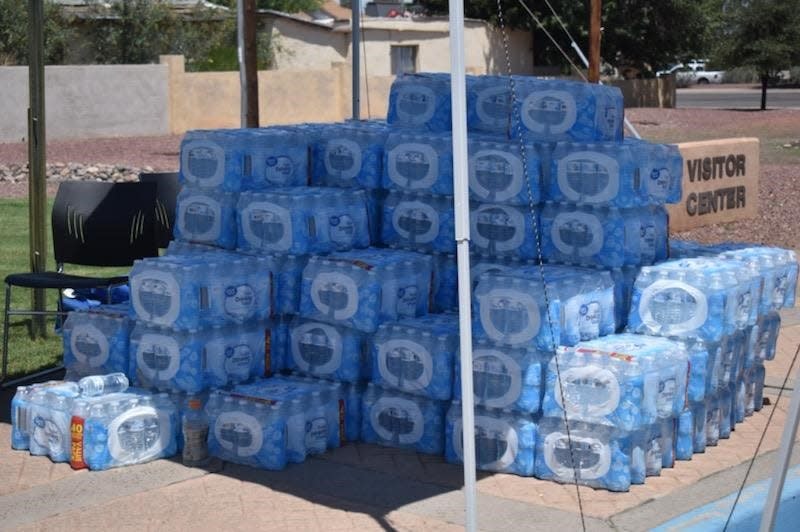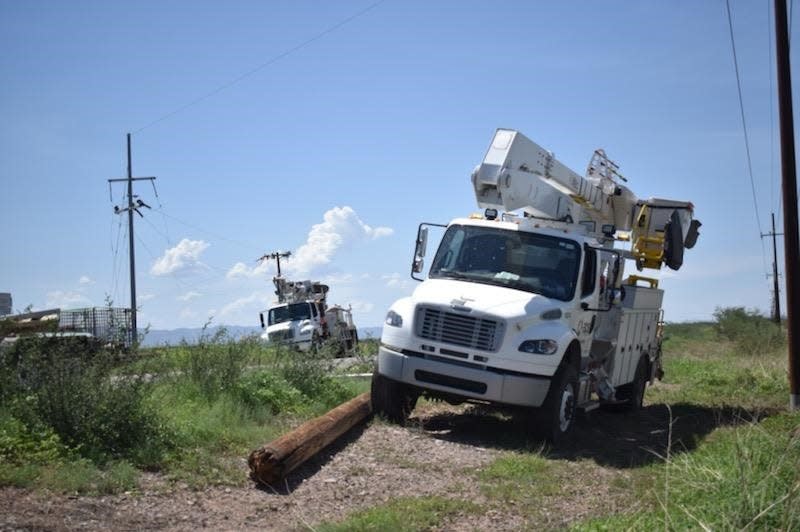With weekend monsoon storm activity set to increase, here's how you can prepare for power outages
After thunderstorms left thousands across Arizona without power for days, and with thunderstorm activity increasing over the weekend, residents are encouraged to prepare in advance.
This monsoon season, Arizona Public Service crews have replaced more than 400 power poles, compared to the 290 poles that are usually replaced each season, according to an APS news release. The winds also blew down large transmission towers and power lines, according to the release.
Salt River Project crews replace about 40 to 100 poles during storm seasons, or on rare occasions up to 140, according to Kathleen Mascareñas, a spokesperson for SRP. Due to Sunday’s storm, they had to place about 193.
Patty Garcia-Likens, another spokesperson for SRP, said that according to the SRP distribution director, the company hadn't seen this much damage — in terms of fallen poles — in the last decade.
At the height of the storm, about 32,000 APS customers and 39,000 Salt River Project customers were out of power. On Monday, more than 4,000 SRP customers and 9,500 APS customers were still affected by power outages due to the weekend storms. About 7,000 APS customers had outages through Wednesday morning.
Wind speeds around 65 mph were recorded in the Phoenix area during the storms, which resulted in the downed power lines and uprooted trees, according to Marvin Percha, a meteorologist with the National Weather Service in Phoenix.
According to the NWS in Phoenix, Sunday’s wind gusts were estimated to be 80-100 mph in the Salt River Pima-Maricopa Indian Community where severe damage was caused.
"I wouldn't say (these damages) are frequent. They're kind of unusual, but they happen a few times during a typical monsoon; you get this localized damage," Percha said.
Heavy monsoon storms also caused major power outages and damaged structures northwest of Douglas, a small town of about 16,000 people in southern Arizona near the Mexico border.
The City of Douglas said that 70 poles collapsed, affecting 331 residents after a heavy storm and high-speed winds hit the area northwest of town.
According to a city press release, APS crews were on site assessing broken structures and working to remove damaged equipment on Thursday, as well as repairing downed poles and wires.
The Cochise County Emergency Management Team set up a cooling station Wednesday in the Douglas Visitor Center, where personnel are giving away free ice and bottles of water to affected residents through Friday. The center is at 345 16th Street, in Douglas.
Power is expected to be restored by Friday morning, however, residents are advised to go online to APS.com/outagemap for more information.
Jesus Oleta, who lives in the affected area and drove through the visitors center parking lot to pick up cases of water, said his porch was damaged during the storm.
“The wind was strong, knocking down trees and poles, it took down parts of my home,” Oleta said. “It took down my porch. We are repairing the porch right now.”

Valley sees less rainfall compared to last year
So far in July, the average rainfall in Phoenix has been lower than last year, according to Bianca Feldkircher, a meteorologist for the NWS in Phoenix. She said the temperature has also been a little bit cooler than last year.
This year, there have been 61 days where the temperature has reached 100 degrees or more, and in 2020 by this time there had been 68 of those days, according to Feldkircher.
While it's still early to determine how active this monsoon season was in southern Arizona, Singer said rainfall has been a little below normal for most parts.
Regarding temperatures, Singer said it has been "much hotter" than it normally is at this time of the year. He said they have been about 3 to 4 degrees higher.
"So we haven't had as much monsoon activity in southern Arizona, so that tends to favor higher temperatures," Singer said.
Monsoon activity in Arizona to increase throughout the weekend
Storm chances are expected to increase in Arizona over the weekend and into next week, according to the National Weather Service.
In northern Arizona, the monsoon season started a little bit earlier than it normally would, bringing a bit more moisture and precipitation, according to Molly Gerhardt, a meteorologist with the NWS in Flagstaff.
In the Phoenix area, there will be an uptick in monsoon activity with 30% to 40% of storm chances on Saturday and 40% to 50% on Sunday, according to Feldkircher. Rain chances will also increase.
The weather pattern that will increase storm chances will remain in place through next week, according to Feldkircher.
On Saturday, temperatures are expected to drop to 105-110 degrees and by Sunday to 100-105 degrees in the Valley.
In southern Arizona, more than 50% chances of afternoon and evening thunderstorms are expected throughout the weekend, according to Marc Singer, a meteorologist with the NWS in Tucson. Thunderstorm chances are expected to stay the same next week.
Singer said temperatures will gradually come down throughout the weekend and will range around 100 degrees.
There is a 30% chance of storms in northern Arizona, with isolated thunderstorms expected especially in the higher elevation areas, according to Gerhardt. There is about a 40% chance of showers in the region.
Temperatures will be in the high 80s and lower 90s in Flagstaff over the weekend. There is an excessive heat warning for the lower elevations of the Grand Canyon and Marble Canyon until Saturday evening.
Early next week, thunderstorm chances will increase to about 70% to 80% in northern Arizona, Gerhardt said.
How to prepare ahead of monsoons:
Crews from utility companies prepare for monsoons throughout the year to respond and restore the power as quickly as possible.
"Based on storm reports and what we're seeing come through, we always have our crews positioned in areas throughout the state where we feel that the storms are going to hit," Lily Quezada, a spokesperson for APS, said. "So as soon as we can get into the areas where they have been impacted, our crews are pretty much ready to move on and restore power."

Customers can also prepare for the monsoon season. These are recommendations from APS and SRP to follow ahead of a storm:
If you are an SRP customer, sign up for outage alerts.
If you are an APS customer, ensure your contact information with the company is up to date so they can reach you in the event of an outage. Customers can do it online or by calling the APS Customer Care Center at 602-371-7171.
If you are an APS customer and use life-support medical equipment that requires electricity, call 602-371-7171 to register for the Medical Preparedness Program.
Keep important numbers handy.
Prepare an emergency supply kit that includes: Prescription medications, a first aid kit, non-perishable food items, water, a battery-operated radio and a portable phone charger.
Keep a backup supply of items for infants, elderly and disabled family members.
Keep flashlights in handy locations along with a supply of fresh batteries.
Install surge protectors to safeguard electronics.
If you have an automatic garage door, check the instructions to learn how to open it manually.
Secure outdoor objects that could blow away or cause damage. Objects found in a typical backyard — such as umbrellas, kiddie pools and even trampolines — can be swept up by high monsoon winds and end up in power lines, causing outages.
During and after the storm, customers should:
Stay inside.
Assume electrical equipment is energized.
If you see fallen power lines, keep your distance and call 911.
Report the outage.
Power down — turn off lights and appliances to avoid a power surge when your power comes back on.
APS customers who have been impacted by a power outage that was 10 hours or longer can be reimbursed for up to 20 pounds of dry ice or 40 pounds of regular ice. Those who buy the ice can keep their receipts and fill out a form at the APS website.
SRP customers with outages that last five hours or more can be reimbursed up to $10 for the cost of ice, according to a company press release. Customers should send an email to help@srpnet.com with the subject line “Ice Reimbursement,” and include their name, address and a copy of their receipt.
Reporter Sarah Lapidus contributed to this report.
Reach breaking news reporter Angela Cordoba Perez at Angela.CordobaPerez@Gannett.com or on Twitter @AngelaCordobaP.
Support local journalism. Subscribe to azcentral.com today.
This article originally appeared on Arizona Republic: Weekend monsoon storm activity to increase in Arizona. Prepare now

